A huge Thank You to the excellent key note speakers, panelists, and all participants at the 9th annual safety of journalists conference at OsloMet University 1-2 November!
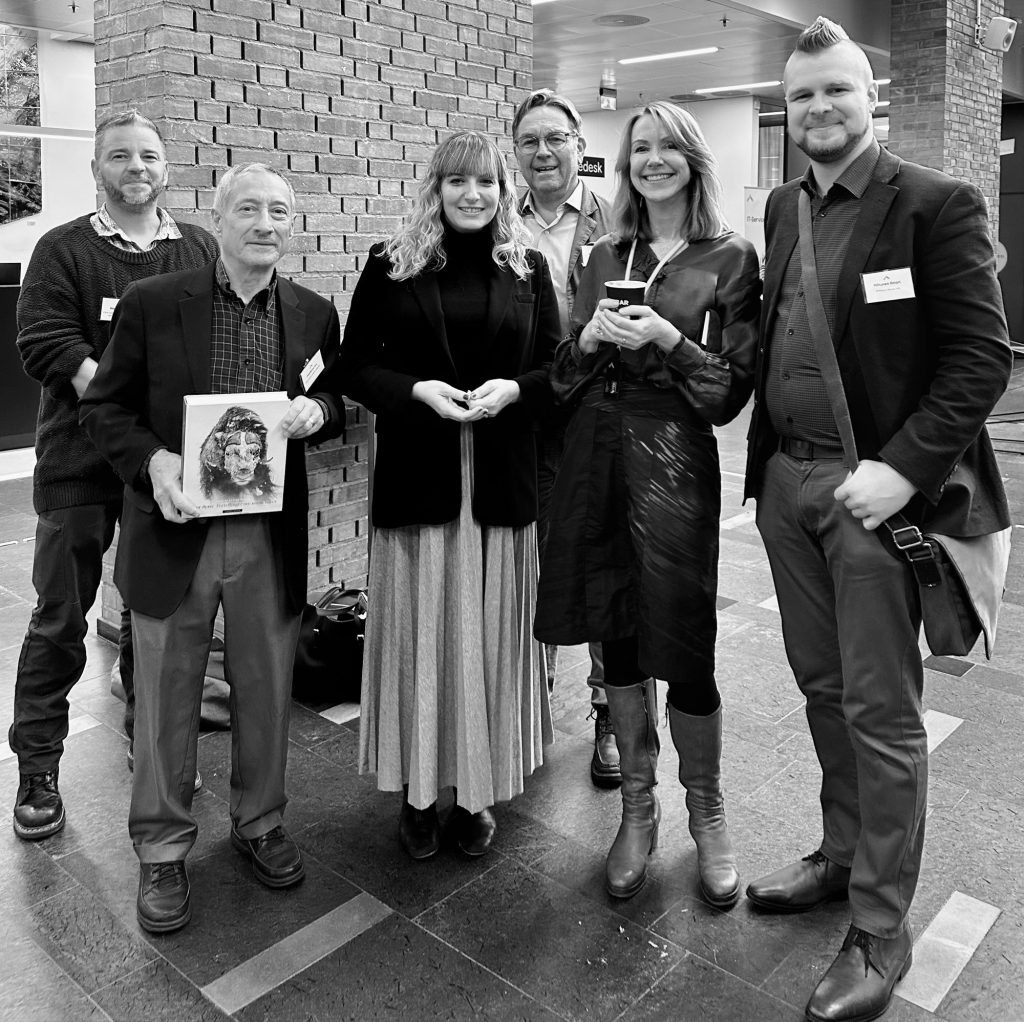
Please find some of the Norpart MA student journalists’ reports from the conference below:
Reporters Without Borders (RSF) and MEKK Join to Advocate for Journalist´s Safety
by Theodorah Munisi, MA student
Opening the 9th International Conference on the Safety of Journalists 2023, Rebecca Vincent, Director of Campaigns, Reporters Without Borders (RSF) honored Norway for ranking at the very top of the World Press Freedom Index, produced by RSF for the past seven years.
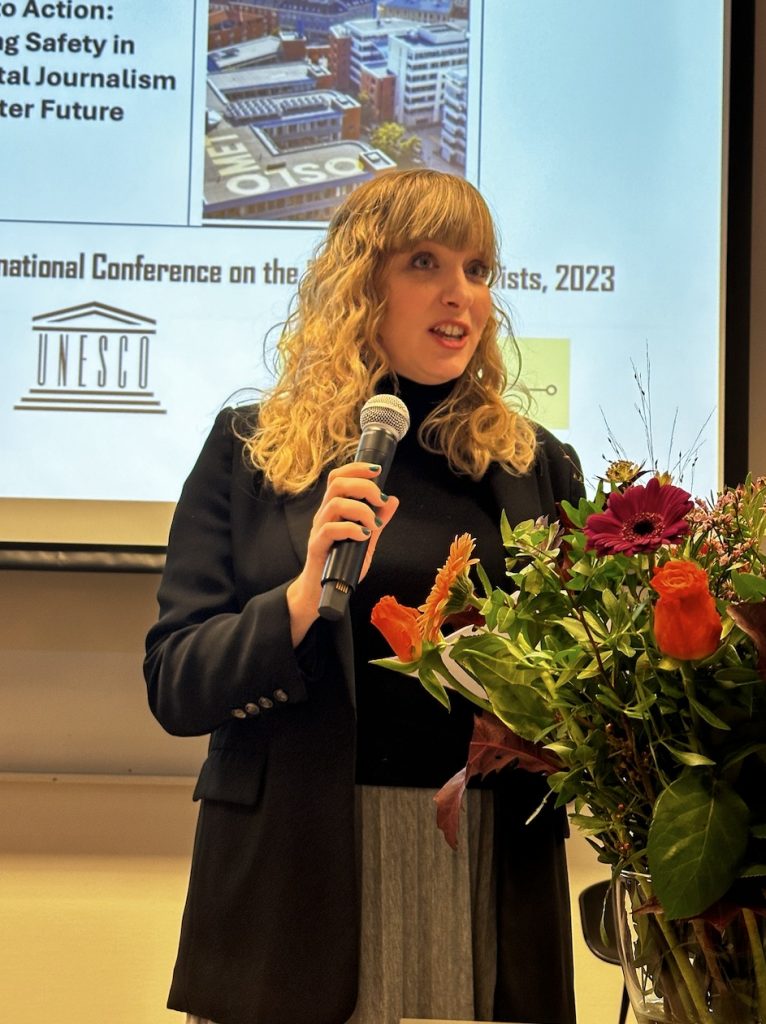
Reviewing the state of the global situation for the safety of journalists, Rebecca says 2023 has been another deadly year for media, and that is largely because of the ongoing extremely violent war in Gaza. She says that RSF is currently investigating cases of 31 journalists killed in Gaza since the 7th of October 2023, and this has been the deadliest conflict for journalists since the Iraq war in 2006.
Rebecca is concerned that physical threats to journalists´ safety and their lives remain a global problem that requires an urgent intervention, and that threats to the safety of journalists is also beyond killings, and stated that as she is addressing the conference, a total of 531 journalists around the globe are currently detained in connection with their work.
Addressing the safety versus the violence towards environmental journalists, Rebecca shared RSF´s data related to the threats faced by environmental journalists around the globe over the past two decades; since 2009 there have been 24 journalists killed in relation to environmental reporting, 170 violations of press freedom linked to environmental reporting and 202 targeted journalists.
Rebecca added that economic pressures, a polarized and unstable political landscape, and other intimidation strategies that come from the authorities and private-sector players have been the most common source of threats and violence toward environmental journalists. Referring to the case of murders of journalist Dom Phillips and indigenous people expert Bruno Araujo Pereira in June 2022, Rebecca says RSF had closely examined the situation of press freedom in the Amazon, which is one of the world´s areas most affected by the climate crisis. Rebecca urged that the fight for free, plural, and independent journalism is closely linked to the climate crisis.
Concluding her speech, Rebecca calls for a collective force and advocacy to ensure better protection for all journalists and find effective ways of addressing threats, to enable environmental journalists to do their jobs safely.
Environmental journalism is one of the most dangerous beats for journalists – Eric Freedman
By Christine Kabazira, MA student.
During the just concluded 9th annual conference on the safety of journalists under the theme “A call to action: Advancing safety in environmental journalism for a better future,” one of the recurring themes was the threats that environmental journalists face in the course of their work. The keynote by Eric Freedman, a Director of the Knight Center for Environmental Journalism at Michigan State University vividly pointed to the dangers of covering the environment beat of news with accounts of journalists who have been murdered, arrested, jailed and sued, threatened or denied access to information. The challenges cut across the continent from the Global South including Africa to Europe and the United States. “It is no surprise that journalism, especially environmental journalism, is considered the most dangerous beat because our work challenges the most prominent people,” noted Freedman on the first day of the conference held at Oslo Metropolitan University.
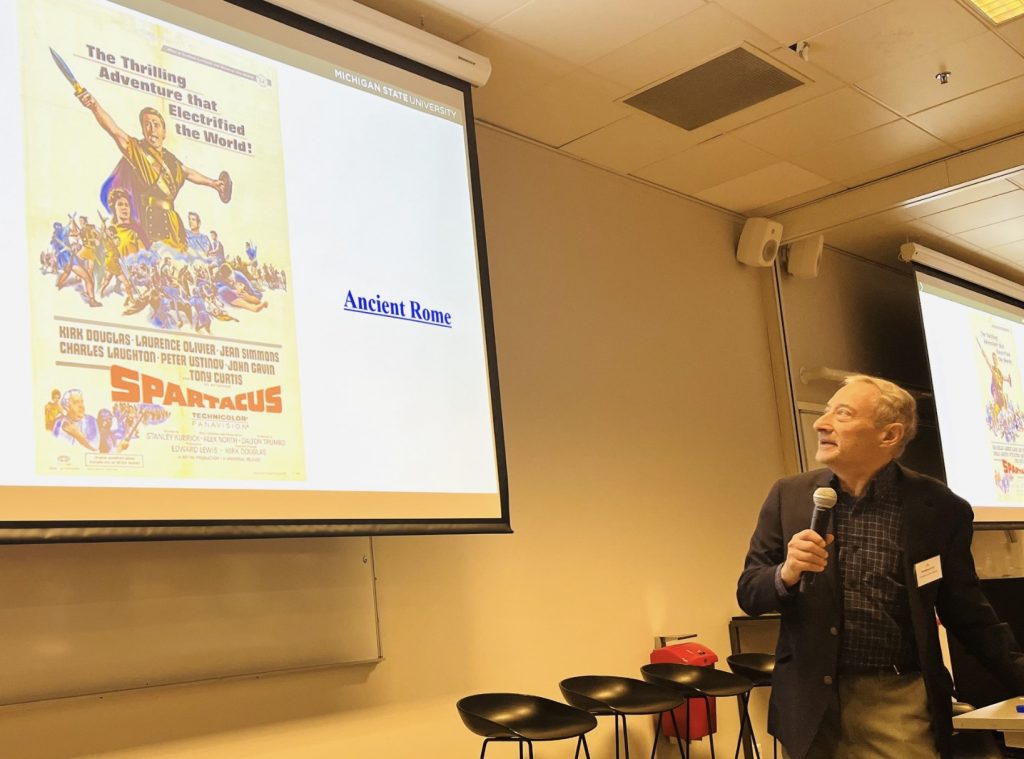
Some of the affected journalists, as presented by Freedman include; Diana Saparkyzy, a Kazakhstan environmental journalist who was assaulted, Rodney Sieh a Liberian journalist jailed and sued, Sam Cowrie, a Brazilian journalist who was attacked, threatened and his equipment destroyed, Tsira Gvasalia, a journalist from the Republic of Georgia who was denied access to information, and Manuel Calloquispe from Peru who was threatened.
A point of concern that emerged from Freedman’s presentation was the fact that journalists who survive these threats are gripped by survivor’s guilt because they are constantly reminded of their colleagues who never made it out alive.
One can only imagine the trauma that the survivor journalists go through. Regarding how these surviving journalists handle traumatic experiences that they encounter throughout their work, during one of the paper sessions, Azania Mosaka, a South African researcher revealed that, in her study on trauma in the newsrooms she found out that some journalists cannot afford counselling services, in some cases. Sometimes, the counselling services are not even available and, journalists like to wear a tough skin and would rather not seek any counselling. Freedman highlighted the same challenges for survivor journalists going through traumatic experiences.
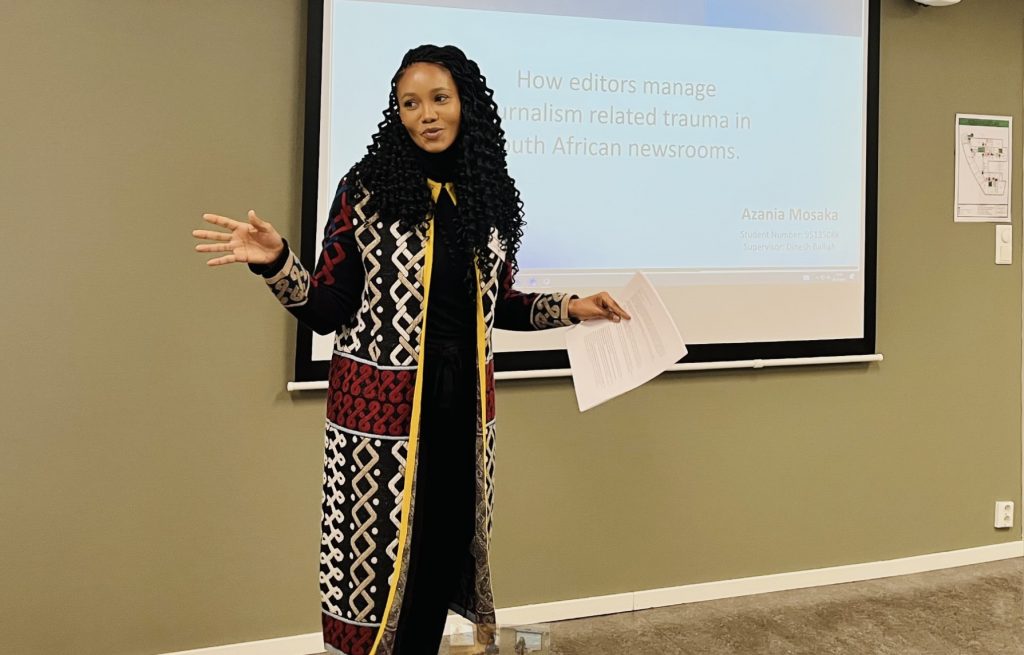
The discussions that transpired throughout the two-day conference involving researchers, journalists, and media organizations brought forward the need to create safety measures for safer reporting on the environment.
Environmental Journalism a dangerous beat
By Theodorah Munisi
At the 9th International Conference on the Safety of Journalists, Prof. Eric Freedman, enlighten the audience on the factual reasons why environmental journalism might be a dangerous beat in the journalism field. The Professor of Michigan State University highlighted issues like journalists´ arrests, denial of access to crucial places and information, and the involvement of influential companies in association with political interests and economic interests which have placed hazardous danger towards the coverage of environmental news and infringed the freedom of the environmental journalists.
But Freedman asks an interesting question to the audience, ´why are journalists targeted? Why has environmental journalism been called one of the world´s most dangerous beats?
Referring to the story of Diana Saparkyzy, a Kazakhstan journalist who was assaulted and forcibly expelled by a group of guards as she went to cover the fatal fire in mines and how the five miners were left dead underground and the other 220 miners being evacuated, Prof. Freedman says such scenario shocked Diana and might discourage her efforts towards reporting stories that have direct effect to the people.
Prof. Freedman argues that the intervention of political power and investment of huge amounts of money involved in some businesses, infringe the freedom of reporting the environmental news because the journalists are spotted as an obstacle towards achieving their planned interests.
In a situation, a Liberian independent journalist, Rodney Sieh was fined US$1.6 million for defamation. The journalist faced the charges because he disclosed a former agriculture minister´s involvement in a corrupt scheme that misused funds intended to fight parasitic, infectious Guinea worm disease. Even though the journalist was released after an intervention of international pressure, the Liberian government strangulated journalists by stopping the coverage of environmental stories that have effects on humans.
The situation is said to be the same in Brazil, hinting at the story of Sam Cowrie, an environmental journalist who was threatened, attacked and his journalistic equipment destroyed in the attempt of trying to report a story about the gold mines, Prof. Freedman insists that even though some journalists survive the harassment, but many undergo severe trauma, with effects on their careers.
So many attacks and attempts to silence environmental journalists discourage and deter watchdog environmental journalists and prevent disclosure of public health hazards, corruption, and incompetence, urges Freedman.
Freedman says journalists reporting local affairs and legal cases on environmental issues like environmental protests against businesses and companies may lead to their arrests, and the arrests involve the journalists in the criminal proceedings initiated by the company, and this makes the journalistic work more difficult because it strains their relationship with the local sources. makes the journalistic freedom difficult.
While quoting Gregoire Souchay, a French journalist `journalists being arrested while conducting their jobs, restricts their journalistic freedom and activities and could discourage other journalists from covering environmental issues and activism`, Prof. Freedman and other journalists’ main concern in these situations is; is if the journalists won´t do it, who will do it?
Making closing remarks, Prof. Freedman helps to answer the very first question he placed ´Why has environmental journalism been called one of the world´s most dangerous beats? ´, he answered that ´it is our work, our essential mission that challenges powerful industries, institutions, and people´. Ensuring a solution-based environmental journalism, the one acting as a watchdog and serving the citizens´ interests, Freedman insisted that journalists stick to truth and impartiality.
Source Safety: The Other Aspect of Journalistic Security.
By Nelson Bahati.
In more than one way, attending the 9th Annual Safety of Journalists Conference at Oslo Metropolitan University was eye-opening. While the conference’s main theme was Advancing Safety in Environmental Journalism, the two studies I attended while I moderated paper sessions on the second day of the conference diverted my attention to an often-overlooked aspect: the safety of journalistic sources.
Ifedoyin Ajayi from Nigeria brought forth intriguing findings from her research on media organizations’ efforts to protect environmental journalists. She revealed that journalists are constantly concerned about the safety of their sources, especially when they share sensitive workplace information, which risks employer retaliation. “Protecting sources isn’t just a courtesy; it’s a necessity,” Ajayi said, emphasizing the perilous position sources find themselves in after confiding in journalists.
Researchers Marina Urbanikova and Llmari Hiltunen presented their comparative study, which covered Estonia, Finland, and the Czech Republic in an equally engaging session. They discovered that investigative journalists were more concerned with the safety of their sources than with their own. While discussing the matter of source safety with Urbanikova and Llmari, shortly after presenting their research, the two agreed that the issue of source protection is indeed important when considering and debating the safety of journalists.
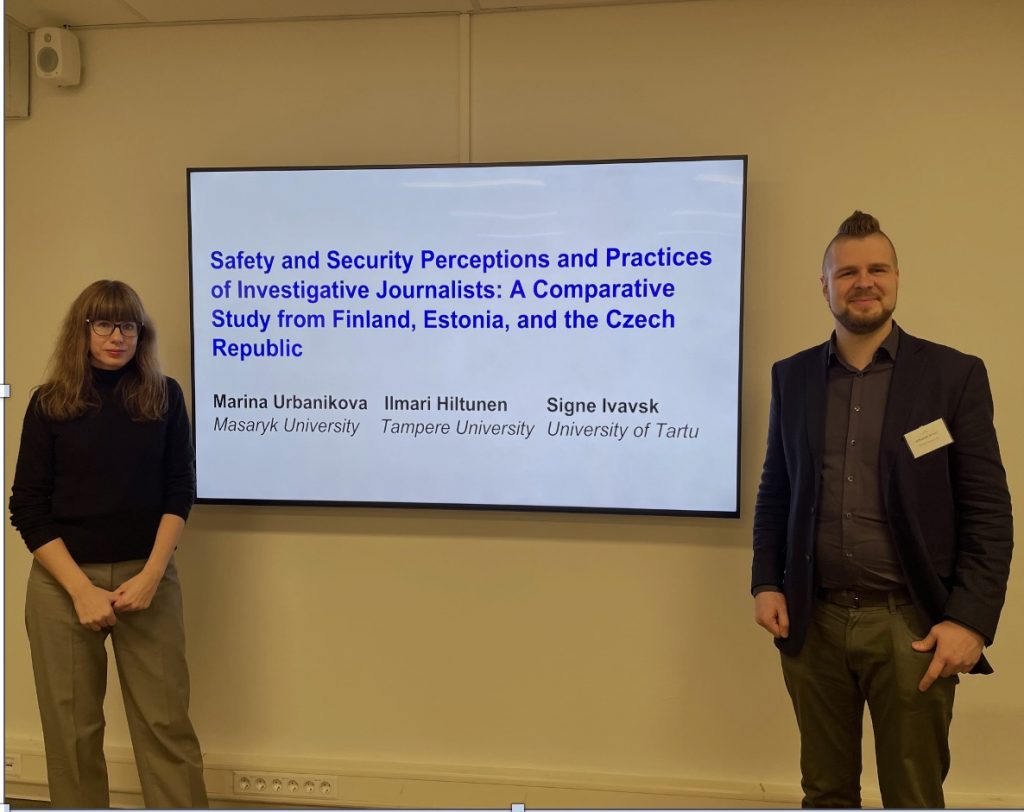
PHOTO: Marian Urbanikova (Left) and llmari Hiltunen (right) after presenting their research during the 9th Annual Safety of Journalists Conference at Oslo Metropolitan University. Photo by: Nelson Bahati.
In fact, Llmari emphasized that, “investigative journalists are skeptical of safety concerns,” and he added that, “safety precautions are time consuming according to some investigative journalists. On this subject, he suggested that safety measures be adjusted such that journalists find them easy to use and that they correspond to the nature of their work—journalism.
Llmari stated that encrypted messaging apps, for example, might be extremely beneficial to journalists, and a simpler method than a lengthy procedure with numerous steps and delays. These discussions struck a chord with me and piqued my interest in learning more about this subject.
In follow-up interviews by email, Urbanikova and Llmari revealed that, in areas where journalists are generally safe, they tend to worry a lot about their sources. This anxiety stems
in part from the high levels of safety enjoyed by journalists in countries such as Estonia, Finland, and the Czech Republic, where their latest research has been conducted.
Still in an email conversation, these researchers disclosed that sources are a valuable asset for investigative journalists, and that without sources, investigative journalists have no work. However, the two highlight that if a source is attacked, other sources will take it as an excuse to stop providing information.
Another important point is that Urbanikova and Llmari emphasized that sources are far more vulnerable than journalists themselves, for reasons such as a lack of awareness of security precautions, whereas journalists are shielded by their public status and profession.
In her thoughts on the subject, Ajayi agrees with this sentiment. “When sources feel at risk, they become reluctant to speak out, which in turn affects the journalists’ ability to report,” she went on to say. “Their right to safety is essential and must be prioritised.” “Sources face many of the same dangers as journalists,” Ajayi explained in a follow up interview on email.
“Assaults, kidnappings, and other forms of violence are prevalent. When sources are compromised, stories can unravel; therefore, protecting them is crucial in debates on journalist safety,” she added.
Urbanikova and Llmari also discussed various levels of risk awareness among sources. “More experienced sources tend to have their own security measures,” they went on to say. “However, those less experienced might require guidance from journalists, which can range from basic tips to a crash course in secure communication.”
These conversations illustrate that while the safety of journalists is crucial, the safety of sources is also important. Ajayi, Urbanikova, and Hiitunen believe that media organizations should not only focus on ensuring the safety of journalists, but also on safeguarding source confidentiality and security.
Reflecting on the plethora of information provided during the conference, it is clear that ensuring the safety of sources is more than a side note; it is a basic part of journalistic ethics.
As we keep calling for journalist safety, let us establish a road to protect those who offer stories reported by journalists.
Journalists as Victimizers? A Shocking Revelation
By Theodora Theodory
Have you ever heard of this phenomenon? I know you’re as surprised as I am, or perhaps you’ve encountered it but stayed quiet due to fear.
For decades, the prevailing view around the world has been that journalists are victims of violence. They face various forms of mistreatment, including harassment, arbitrary detention, arrests without warrants, property confiscation, and, in extreme cases, even
torture, mysterious disappearances, and killings.
According to UNESCO, from 2006 to 2023, over 1600 journalists have been killed, and in 9 out of 10 cases, justice remains elusive. This leaves us with one burning question: Who is responsible for these atrocities?
To answer this question, let’s delve into a case study in Ethiopia. Gezahgn Berhie Kidanu, a lecturer in the Department of Journalism and Communication at Bahir Dar University, conducted a research study on Journalist Safety in Ethiopia. He made a startling discovery:
the perpetrators of these acts of violence include the state, shadowy forces (such as the Government media committee), non-state actors, and even fellow journalists themselves.
Kidanu presented his findings during the 9th International Conference on the Safety of Journalists organized by MEKK at Oslo Metropolitan University from November 1 to 2, 2023. This conference brought together researchers, educators, Ph.D. holders, journalists, fact checkers, and other stakeholders from around the world to share experiences and seek solutions to end impunity for crimes against journalists.
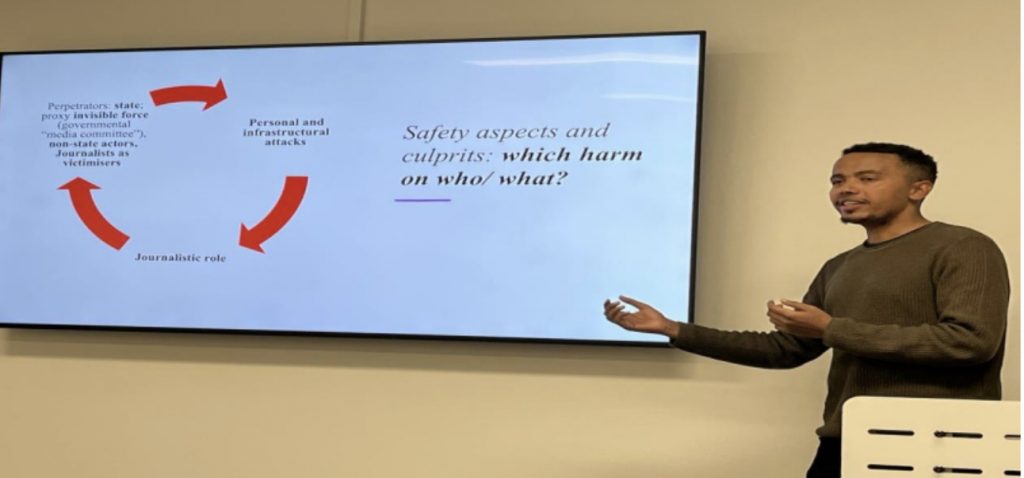
A lecturer in the Department of Journalism and Communication at Bahir Dar University Gezahgn Berhie Kidanu, presenting a Paper on Journalists’ Safety in Ethiopia During the 9th International Conference on the Safety of Journalists organized by MEKK at Oslo Metropolitan University from November 1 to 2, 2023
Kidanu’s research presentation has left professors, researchers, and educators pondering how this could be possible. Journalists have turned into perpetrators of violence against their own colleagues! According to Kidanu, these journalists collaborate with the state and other powerful figures to target fellow journalists and their properties.
When answering question from Professor Kristin Skare Orgeret about his own safety while conducting such sensitive research, Kidanu revealed that he remains relatively unknown and not famous to many, which has helped him gain cooperation from those journalists.
One of the session presenters, Christine Kabazira, a Masters student, expressed her admiration for Kidanu’s presentation, stating that the revelation of journalists attacking their peers is a new and crucial topic that requires further research. She emphasized that failing to
address this issue would hinder the fight against impunity for crimes against journalists.
Despite regional and international efforts, UNESCO’s statistics on journalist killings and unresolved cases continue to trouble practitioners, researchers, and other interested parties.
However, the phenomenon of journalists attacking their colleagues represents another front in the battle against violence that must be addressed at its inception, as noted by Theodora Munisi, a Journalism Masters student at Oslomet.
Preventative Strategies and Reparative Responses
By Caroline Malewo, master student
During the paper session titled Preventative Strategies and Reparative Responses at the 9th Annual Conference on the Safety of Journalists at OsloMet, Dawn Wheatley presented on how Journalists in Ireland use filtering practices to manage negative interactions online such as closing Direct Messages, blocking, muting, or turning off replies.
Through conducting interviews Dawn’s research found out how do journalists filters appear to the public and if is what they should be doing. It also found answers to what should journalists do to stay safe online as well as how does being contactable and interacting on social media help journalists on their career.
Dawn told us that ‘muting followers feels more nuanced than blocking. This is because people do not know that they have been muted different from blocking which they can see and can even take a screenshot’.
Dawn quoted an interviewee explaining employer’s expectations on the journalist’s online visibility by saying ‘I try not to block…maybe this is just me…. We are putting our reports out there and your employer is tagging you when they put your reports out there’.
Dawn concluded by saying that journalists in Ireland are taking actions online and are mindful of reasons why regaining control online in some form is vital. According to Dawn journalists in Ireland are aware of their role as contactable, public figures while striking balance with personal boundaries.
Automatic early-warning system
By Caroline Malewo, master student
In a world where disinformation online can quickly escalate into physical violence, the safety of journalists has never been more critical. At the Safety of Journalists Conference 2023, Stefan Brenner presented a paper titled ‘A first concept for an automatic early-warning system designed to protect at-risk journalists.
Stefan told us that this research paper aims at understanding and predicting when the piece of misinformation and disinformation becomes a physical threat. Stefan said that
‘disinformation online can turn into physical violence thus Journalists themselves are left to decide if they want to leave or continue to be online’.
Stefan’s presentation emphasized the need for an automatic early-warning system that could act as a crucial tool to assist in assessing the safety of journalists. However, it is important to note that this system is not designed for automated decision-making. Instead, it offers automated data evaluation to provide essential insights.
Despite its potential, Stefan concluded that the automatic early-warning system does come with limitations and inherent risks such as the inability to predict actions of violent lone attackers, organized criminal groups, or state actors. It also lacks access to real-time social media data, which is crucial for assessing risks effectively.
Environmental Book Clubs in Journalism Culture
By Caroline Malewo, master student
In a world filled with stress and emotional challenges, the role of literature and book clubs in promoting psychological well-being has gained significant attention. This was evidenced through Mercedes de Luis Andre’s presentation on her research paper titled Environmental book clubs in Journalism culture- Literature Review.
Mercedes said, ‘I saw that journalists separate people instead of uniting them that is why I went back to my university and introduced a book club’.
Her research aims at addressing key questions such as how does bibliotherapy work with literary texts in individuals and groups experiencing psychosocial distress?
Mercedes explained notable findings from her research including effectiveness of bibliotherapy in education, sharing experiences and rehabilitation, with examples such as poetry therapy and cinema therapy. The power of book clubs is also evident in the way they encourage critical thinking, empathy, and a deeper understanding of various issues.
Mercedes concluded by explaining the next step to her research where she plans to work with three book clubs in media culture, including “Club de Lectura Naomi Klein” (Madrid, Spain), “Club de Lectura Accion Climatica” (Buenos Aires, Argentina), and “En Plan Planeta” (Cantabria, Spain).
